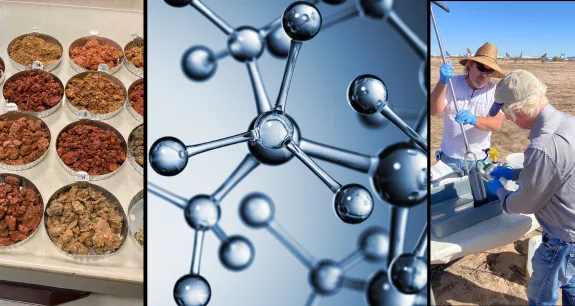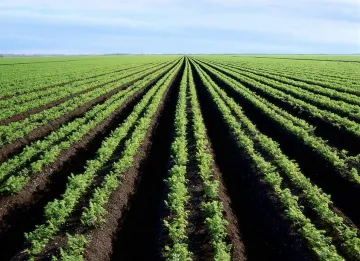
National Collaborative PFAS Project
The National Collaborative PFAS Project, coordinated by the University of Arizona’s WEST Center, is designed to: 1) evaluate the incidence and mobility of PFAS in soils with a history of land application of biosolids, and 2) assess potential crop uptake of PFAS from these soils.
WEST Center Director, Dr. Ian Pepper, is leading the study, with other contributors including Dr. Marc Brusseau; researchers at the Arizona Laboratory for Emerging Contaminants (ALEC); and experts around the country. The project began in 2022. By early 2026, Phase 1 analyses of soil and water samples were complete, and the first peer-reviewed article published. Phase 2, which focuses on potential crop uptake, is well underway.
Background

EPA regards PFAS as emerging chemicals of concern due to potential adverse health effects. In 2016, the EPA Health Advisory levels for PFOS and PFOA went from a combined 600 parts per trillion (ppt) down to a combined 70 ppt. On June 15, 2022, EPA further reduced the levels to 0.004 ppt for PFOA and 0.02 ppt for PFOS. Since all biosolids contain some PFAS compounds, this has led many U.S. states to be concerned about land application of biosolids due to the potential for PFAS contamination of groundwater used as a potable water source. These concerns prompted a 2022 ban on biosolids application in Maine with other Northeastern States considering similar legislation.
Only a couple years earlier, in 2020, a temporary moratorium on land application was placed on biosolid disposal in Pima County, AZ for similar reasons. In response, researchers from the University of Arizona and Pima County Wastewater partnered to conduct an in-depth local study to evaluate risks from PFAS in biosolids. Data showed that input of PFAS from long-term application of biosolids was minimal at local agricultural sites and concentrations decreased rapidly with depth. Due to this collaborative study, the moratorium on land application was rescinded in Pima County in November 2020 (Pepper et al., 2021).
Project Concept
Following the success of the Pima County study to evaluate PFAS risks at a local level, the University of Arizona initiated the National Collaborative PFAS Project to better understand the incidence and mobility of PFAS from biosolids in diverse environments across the country. Specifically, the study asks, “Does land application of biosolids result in significantly increased human exposure to PFAS?”
- Phase 1 (2022-2026): This phase of the study seeks to evaluate exposure risk by measuring PFAS in soils and groundwater across the United States. Study sites vary by soil type, depths to groundwater, climate, and irrigation practices. Collected field data were analyzed and reported to sites and published in the journal, Science of the Total Environment, in early 2026. Data will be additionally utilized to validate a screening level transport model that predicts the potential of PFAS leaching to groundwater.
- Phase 2 (2025-2027): Phase 2 of the study investigates potential plant uptake where biosolids are used as a soil amendment. Crops being analyzed include alfalfa, barley, corn, cotton, grasses, oats, peas, rye, soybeans, triticale, and wheat.
Methodology

The National Collaborative PFAS Project is funded by generous donations from utilities, private sector companies, and non-profit organizations. The extensive study has enrolled 25 sites* from 16 states to assist with soil, water, and plant sampling (see map). The team at WEST Center supports participating sites by providing a sampling kit with supplies and equipment; instructing sites regarding standardized sampling methods and protocols to prevent PFAS contamination (SOP and instructional video); and meeting with site representatives to discuss the project and answer questions.
At each site, personnel work pro-bono to sample soils and plants within three (3) plots. Appropriate blanks (travel, field, and equipment) are also collected.
- Control plot – no biosolids
- Low biosolids rate land application plot
- High biosolids rate land application plot
During Phase 1, soil samples were obtained from each plot via a soil core at 1’, 3’ and 6’ depths. Three cores were taken from each plot, resulting in a total of 27 soil samples (3 plots x 3 cores x 3 depths). Whenever possible, corresponding groundwater samples were also obtained. During Phase 2 -- currently in progress -- plant samples are obtained from each plot. All samples are shipped to the University of Arizona Water and Energy Sustainable Technology (WEST) Center where they are processed and subsequently analyzed for 25 PFAS at ALEC.
* The number of participating sites varies slightly by study phase.
Progress to Date
Progress updates below describe completed and in progress activities as of the end of 2025.
Additionally, the first peer-reviewed publication (citation below) contains detailed information about the study and Phase 1 PFAS incidence and mobility results.
Ian L. Pepper, Sarah M. Prasek, Jon D. Chorover, Frank J. Prevatt, Danielle M. Barrientes, Greg Kester, Mark L. Brusseau (2026). National collaborative study on the incidence and mobility of PFAS following land application of biosolids. Science of The Total Environment, Volume 1012, 2026. 181197, ISSN 0048-9697. https://doi.org/10.1016/j.scitotenv.2025.181197.
Updated January 2026





